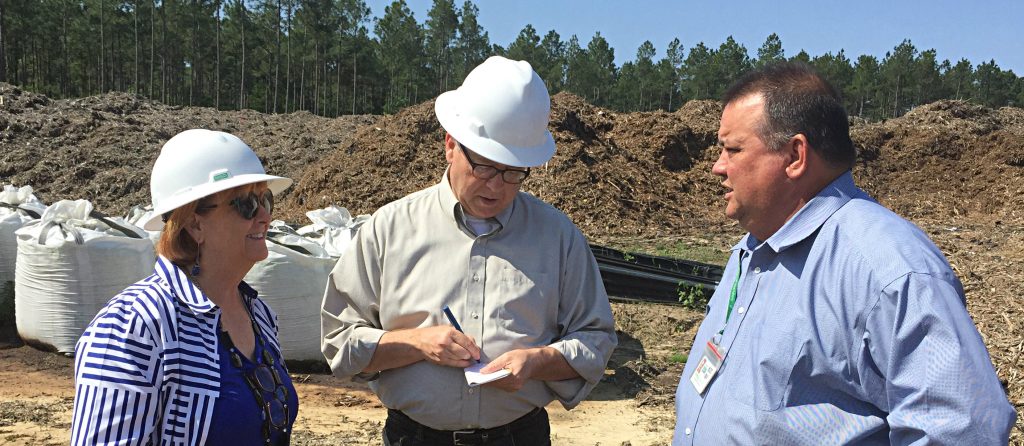Emerald Coast Utilities Authority has moved into recycling in a big way with its Compost facility and the $9.5 million, state-of-the-art Interim Materials Recycling Facility under construction at the Perdido Landfill.
ECUA began its composting operations in March 2016. The facility may make yard waste landfills obsolete by mixing the grass, leaves, pine straw and other such waste collected throughout the community with biosolids from the Central Water Reclamation Facility (CWRF) to create nutrient-rich compost for the commercial market.
The compost facility is located on 15 acres just inside the gate at the CWRF in the Cantonment area. On a daily basis, it can handle 400 cubic yards of yard waste and 80 tons of biosolids, treated sewage sludge from the CWRF that meets the EPA requirements for land application and surface disposal.
ECUA PIO Jim Roberts and Board member Vicki Campbell recently gave Inweekly a tour of the facility and explained the process. The yard waste is first run through a grinder before it is ready to be placed in windrows.
“The way the windrow works is we lay a bed down of yard waste, then we bring in the sludge from biosolids that have been processed only about 200 yards for here, so there is not a lot of transportation cost at all,†said Roberts.
“We bring the sludge into the middle of the layer, and then we put on the topping layer,†he said. “Then we added the inoculate, millions and billions of micro-organisms that actually eat all the worms and clean it all up and stabilize it.â€
The windrows are turned twice during the next 45 days. They have heat sensors to make sure the inoculate is working properly. The temperature of a windrow ranges from 155 degrees to less than 131 degrees. After the month and half, the debris is run through another grinder that makes the compost ready for use.
“When we had our manufacturing day here, we invited a lot of manufacturers and different processing companies,†said Roberts. “The one thing they were amazed about was the smell. A lot of composts are based on cow manure and chicken. If you pick up and smell our compost, it smells like rich dirt, which is the way you know you’ve got great product.â€
Two manufacturers are buying all the compost generated at the facility and selling under the brand “Emerald Coast Bloom.†Campbell would like to see it made available to the public.
“We have to work out the details, but I think this something the public would love to have,†she told Inweekly.
Randy Rudd, ECUA deputy executive director of shared services, said the compost operation was currently using half of the biosolid output from the CWRP, but it will be using all of the biosolids. The ECUA board recently approved the purchase of a tarp to provide cover for the windrows from rainfall.
Roberts said the ECUA has begun encouraging the public and landscape companies to use compostable brown paper bags. He pointed to the shredded, plastic bags floating in the wind on the site.
“Plastic bags don’t decompose and cannot be processed into environmentally-friendly compost or mulch,†he said. “The paper yard waste bags can be found in home improvement centers, large retailers and local garden centers.â€
Campbell pointed out that the compost operation eliminates the need for the dryers that have been used to process the biosolids in the past, because the windrows would soon be using all the biosolids. She estimated the savings would be more than a million dollars annually.
Inweekly also toured the construction site for the Interim Materials Recycling Facility (IMRF). For years, ECUA and Escambia County have battled over how to best process recycling. In 2013, the Board of County Commissioners considered asking the state legislature to abolish the utility authority so that it could be consolidated into county operations.
Since Jack Brown came on board as county administrator in June 2014 the county and ECUA have had a more cooperative spirit. In February, they broke ground on the IMRF that ECUA agreed to build on the 120,000 square-foot site adjacent to the Escambia County Perdido Landfill.
The IMFR will include a 50,000 square-foot fabric building that will house the material sorting equipment. It will be able to handle 165 tons of recyclable materials daily with an estimated capacity of 40,000 tons.
When Inweekly visited the city, the work crews were making the last concrete pour on the foundation. Rudd expected the building to be finished by the end of June. The material sorting equipment would arrive and be installed in July. In August, ECUA would test the equipment and be ready to start operations in September.
“When IMFR opens, we will become a regional recycling facility,†said Campbell. “We can bring outside dollars into this community, which will help us keep our rates low.â€
Campbell, who is up for re-election this year, said she is often asked about the county’s recycling program.
“I tell people that we are getting into it in a big way,†she said. “We will have a program that we can all proud of.â€
